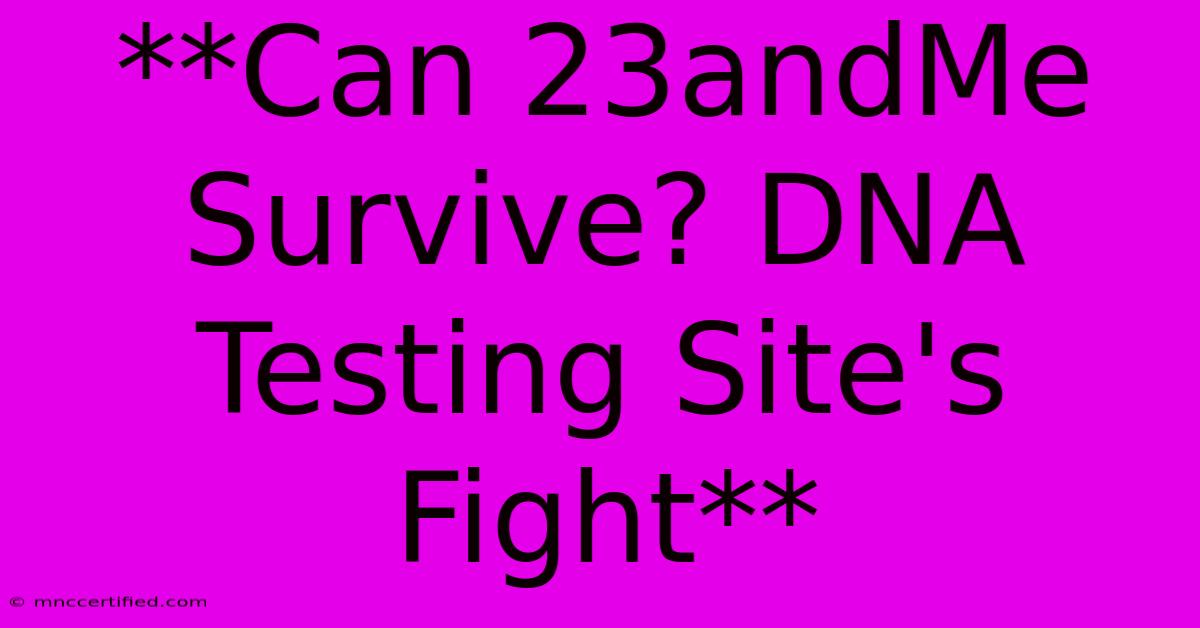**Can 23andMe Survive? DNA Testing Site's Fight**

Table of Contents
Can 23andMe Survive? DNA Testing Site's Fight for Relevance in a Shifting Landscape
23andMe, a pioneer in the direct-to-consumer DNA testing market, has faced significant challenges in recent years. The company, known for its ancestry and health reports, finds itself battling fierce competition, evolving regulations, and shifting consumer interest. But can 23andMe survive and thrive in this increasingly complex landscape?
The Rise and Fall (and Rise Again?) of a Genetic Giant
23andMe burst onto the scene in 2006, offering affordable, at-home DNA tests that revealed ancestry and genetic predispositions. The company quickly gained popularity, fueled by consumer curiosity about their heritage and health risks. By 2013, 23andMe boasted over a million customers, but a clash with the Food and Drug Administration (FDA) over its health-related claims forced a temporary halt to its health reporting services.
After years of working with the FDA, 23andMe received authorization to provide reports on certain genetic health risks. However, the regulatory hurdles and the emergence of new players in the market created significant challenges for the company.
The Competitive Landscape: A DNA Testing Battleground
The DNA testing market has become a crowded field, with competitors like AncestryDNA, MyHeritage, and LivingDNA vying for customers. These companies have aggressively expanded their offerings, emphasizing genealogy services and personalized insights while also lowering prices.
Additionally, new players have entered the market with innovative approaches. Companies like Nebula Genomics offer whole-genome sequencing, providing a more detailed genetic picture. This increased competition has put pressure on 23andMe to differentiate itself and offer compelling value to potential customers.
Beyond Ancestry: 23andMe's New Focus
To stay relevant, 23andMe has diversified its offerings beyond traditional ancestry and health reporting. The company has expanded into:
- Pharmaceutical Partnerships: 23andMe collaborates with pharmaceutical companies to leverage its vast genetic database for drug development and research.
- Personalized Health Insights: The company offers personalized health insights based on genetic data, including recommendations for nutrition and fitness.
- Therapeutic Development: 23andMe is actively involved in developing new therapies for genetic conditions based on its research and insights.
The Future of 23andMe: Challenges and Opportunities
While 23andMe faces significant challenges, including regulatory scrutiny, intense competition, and evolving consumer preferences, the company also has several opportunities for growth:
- Leveraging its Genetic Database: 23andMe possesses one of the largest and most diverse genetic databases, a valuable asset for research, drug development, and personalized medicine.
- Data-Driven Insights: By analyzing its vast genetic data, 23andMe can provide increasingly accurate and personalized health insights.
- Expanding into New Markets: The company has opportunities to expand into new markets, such as fertility services and genetic counseling.
Conclusion: Can 23andMe Stay Ahead?
The future of 23andMe will depend on its ability to adapt to the changing landscape of the DNA testing market. The company must continue to innovate, invest in research and development, and offer compelling value to its customers. By leveraging its genetic database, expanding its offerings, and embracing data-driven insights, 23andMe can solidify its position as a leading player in the evolving world of DNA testing and personalized healthcare.

Thank you for visiting our website wich cover about **Can 23andMe Survive? DNA Testing Site's Fight**. We hope the information provided has been useful to you. Feel free to contact us if you have any questions or need further assistance. See you next time and dont miss to bookmark.
Featured Posts
-
Can You Cancel A Claim On Car Insurance
Nov 08, 2024
-
Pressure Mounts For Early German Vote
Nov 08, 2024
-
What Hospitals Accept Ambetter Insurance
Nov 08, 2024
-
Uk Doctor Endorses Hamas Armed Conflict
Nov 08, 2024
-
Sancho Recovering Says Maresca
Nov 08, 2024